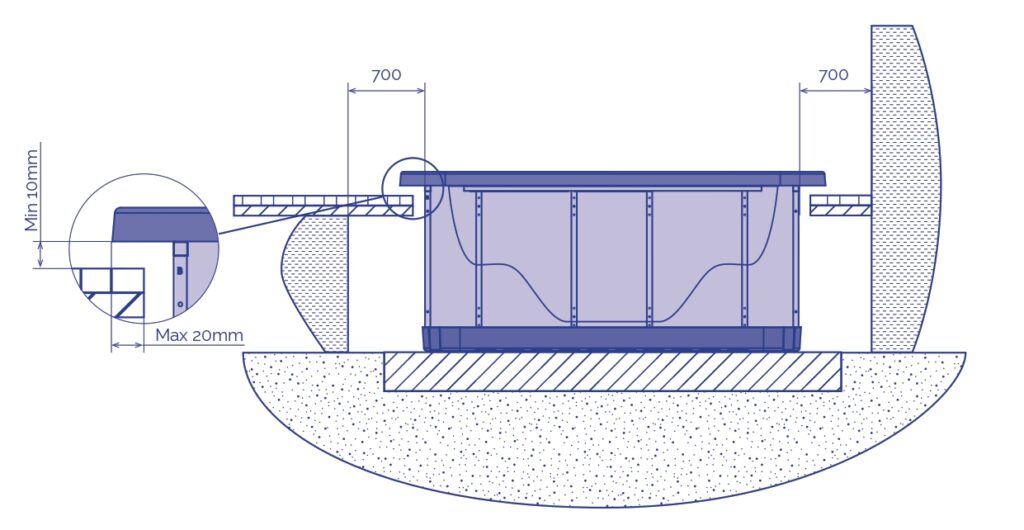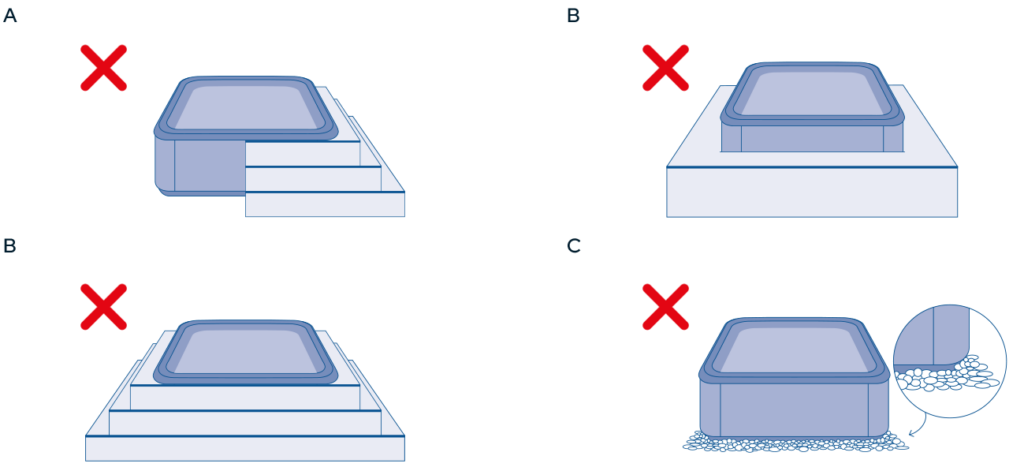Before installing and assembling the Spa, ensure that the packaging of the Spa is in perfect condition. Contact your distributor immediately if the packaging is damaged.
Position the Spa horizontally, placing the whole base of the unit on a smooth, fl at and level surface, capable of supporting the weight when used (full of water, plus the weight of the bathers).
The Spa cannot be placed on a curved surface or on blocks.
Some of the requirements for the floor under and around the spa must be considered, such as: firmness, water resistance, non-slip surface, maximum slope, horizontality, homogeneity, andi surface free of sharp objects, among others.
Anchoring and support equipment is required to avoid damage due to misalignment.
There is a requirement that the supporting materials must be of sufficient strength to withstand the maximum design load of the spa, spa water, bathers, all appurtenances and elements (e.g., a gazebo). It is recommended that a qualified contractor or structural engineer be consulted to verify this requirement, even when the spa is installed on a suspended floor (balcony, deck or decking).
It is important to note the minimum clearance around the entire spa for any electrical devices or supplies (e.g., electrical outlets) in accordance with applicable regulations.
The side where the motors are located should be fully accessible. In order to carry out maintenance tasks, the location of the Spa should enable it to be moved so that all its sides can be easily accessed.

Environmental conditions, such as groundwater and frost risk, must be taken into account. Professional installers should inform the customer of these conditions.
For portable above-ground spas without fl oor insulation, consideration should be given to the use of an insulating liner under the spa to reduce heat loss through the bottom of the spa.
OUTDOOR INSTALLATION
If an outdoor location is chosen to place the Spa: Do not expose the Spa to sunlight when it is empty and without a protection cover. Remember that prolonged exposure to sunlight may damage the surface of the Spa and its accessories. Acrylic rapidly absorbs heat from the sunrays reaching very high temperatures which will damage the Spa. Maximum absorption temperature is 60ºC.

It is recommended to place the Spa away from trees, as falling leaves may block the filter.
If the Spa is placed inside glass structures, prevent sunrays shining directly on the Spa through the glass, as the temperature could be excessively hot.
INDOOR INSTALLATION
It is recommended to ensure drainage in the area of the Spa, to prevent water from accumulating around it and to avoid dangerous access areas for bathers.
Remember that the operation of the Spa causes increased damp and therefore, there must be a ventilation system to prevent damp from accumulating which could cause damage in the room where the Spa is located.
The use of a cover reduces heat loss and damp in the room.
It is recommended to take into account local regulations when indoor installing.
INGROUND VERSION
The Spa structure must be fixed on the floor. Do not hold the Spa by its outer edges.

Once settled the Spa, finish the work bearing in mind that the edging of the surface must not be in direct contact with the work (a minimum of 1 cm must be left around the edge).
Bear in mind that you will have to leave enough space around the spa for maintenance. This space should be at least of 0.7 meters.
To seal the tab to the Spa, use a special elastic silicone for aquatic installations.
Never fill the hot tub’s upper profile with cement or any other material that expands/ contracts differently to the shell. This would lead to the hot tub cracking. Never concrete over the hot tub’s pipes or accessories.

ESSENTIAL SPA WARRANTY INSTRUCTIONS
To ensure the longevity of your spa furniture, it is important to follow these instructions focusing on the ventilation of the furniture:

Be sure to provide adequate ventilation for your furniture to prevent possible warping.
